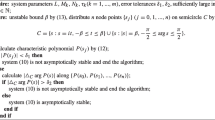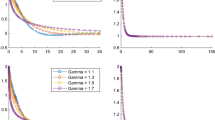Abstract
Approximate solution of the differential equations of state of continuous systems by various numerical integration schemes is standard practice in trajectory optimization and control work; the resulting truncation error represents the main error in many applications. Suppression of the deleterious effects of this error is of increasing interest as double-precision arithmetic becomes routinely available for roundoff error reduction, especially when high overall accuracy is needed. In numerical optimization of trajectories, the accuracy of partial derivatives is important in a special sense: compatibility of a function and its derivatives. That is, if the partial derivatives of the terminal state with respect to trajectory parameters are accurate representations of the partial derivatives of the terminal state calculated through the integration model, adverse effects on convergence of successive approximation iterations can be avoided. From previous numerical experiments, this is known to be particularly important when conjugate-direction methods are used, as they require unusually accurate first partial derivatives to realize the quadratic convergence theoretically attainable.
When the mathematical model of the system consists of differential equations, it is theoretically correct to use differential equations for the adjoint variables (influence functions) as well. However, the actual numerical solution of both state and adjoint variables is obtained by using finite-difference approximations. Truncation errors in the state are inevitable; but, by suitable construction of the adjoint difference equation, it is possible to obtain the compatibility just discussed. The procedure is to recognize that, for numerical purposes, the system model consists of difference equations and directly derive compatible adjoint difference equations. The adjoint variables are then the correct influence functions for the numerically computed state variables, rather than approximate influence functions for the theoretically continuous state variables. The construction of the adjoint system for difference-equation models is straightforward. For example, if the typical integration routine involves fourth-order differences, the adjoint system also involves fourth-order differences. However, the intervals and coefficients for the adjoint system differ from those of the dynamic system. Thus, the compatible adjoint system uses difference equations of the same order in a different, although quite connected, integration routine.
Similar content being viewed by others
References
Kelley, H. J., andMyers, G. E.,Conjugate Direction Methods for Parameter Optimization, Paper presented at the 18th International Astronautical Congress, Belgrade, Yugoslavia, 1967.
Athans, M.,The Status of Optimal Control Theory and Applications for Deterministic Systems, IEEE International Convention Record, New York, 1966.
Halkin, H., Personal Communication, 1964.
Halkin, H.,A Maximum Principle of the Pontryagin Type for Systems Described by Nonlinear Difference Equations, SIAM Journal on Control, Vol. 4, No. 1, 1966.
Mayers, D. F.,Methods of Runge-Kutta Type, Numerical Solution of Ordinary and Partial Differential Equations, Edited by L. Fox, Addison-Wesley Publishing Company, Reading, Massachusetts, 1962.
Kelley, H. J., Denham, W. F., Johnson, I. L., andWheatley, P. O.,An Accelerated Gradient Method for Parameter Optimization with Nonlinear Constraints, Journal of the Astronautical Sciences, Vol. 13, No. 4, 1966.
Author information
Authors and Affiliations
Additional information
This paper was presented at the Second International Conference on Computing Methods in Optimization Problems, San Remo, Italy, 1968. The research reported in this paper was carried out under Contract No. NAS 9-7805 with the NASA Manned Spacecraft Center, Houston, Texas.
Rights and permissions
About this article
Cite this article
Kelley, H.J., Denham, W.F. Modeling and adjoints for continuous systems. J Optim Theory Appl 3, 174–183 (1969). https://doi.org/10.1007/BF00929442
Received:
Issue Date:
DOI: https://doi.org/10.1007/BF00929442




